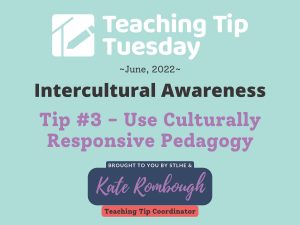
What is Culturally Responsive Pedagogy (CRP)?
Culturally responsive pedagogy is defined as “teaching that integrates a student’s background knowledge and prior home and community experiences into the curriculum and the teaching and learning experiences that take place in the classroom” (Ontario Ministry of Education, 2013, p. 2).
Why Should I Use CRP?
Schools/learning environments have an obligation to ensure that all learners feel safe, included, and accepting of diversity. Educational institutions and teachers need to use culturally responsive pedagogy to create welcoming classrooms, dispel cultural assumptions, embrace linguistic diversity, and support diverse strategies.
Where Can I Find More About CRP?
- Inclusive and culturally responsive teaching – Teaching and Learning | University of Saskatchewan. (2019). Usask.ca. https://teaching.usask.ca/strategies/inclusive-and-culturally-responsive-teaching.php#Whoneedsinclusiveteachingpractices
- Culturally Responsive Teaching: A Reflection Guide. (2019). New America. https://www.newamerica.org/education-policy/policy-papers/culturally-responsive-teaching-competencies/
How Can I Begin to Use CRP?
There are 8 competencies that you can develop and reflect on that will help you be a culturally responsive teacher:
Competency 1 – Reflect on One’s Cultural Lens
Competency 2 – Recognize and Redress Bias in the System
Competency 3 – Draw on Students’ Culture to Shape Curriculum and Instruction
Competency 4 – Bring Real-World Issues into the Classroom
Competency 5 – Model High Expectations for All Students
Competency 6 – Promote Respect for Student Differences
Competency 7 – Collaborate with Families and the Local Community
Competency 8 – Communicate in Linguistically and Culturally Responsive Ways
…See you next week for a new tip!
Attribution Statement: This resource was adapted from
- Inclusive and culturally responsive teaching – Teaching and Learning | University of Saskatchewan. (2019). Usask.ca. https://teaching.usask.ca/strategies/inclusive-and-culturally-responsive-teaching.php#Whoneedsinclusiveteachingpractices CC-BY-SA 4.0
- Culturally Responsive Teaching: A Reflection Guide. (2019). New America. https://www.newamerica.org/education-policy/policy-papers/culturally-responsive-teaching-competencies/ CC-BY-SA 4.0
